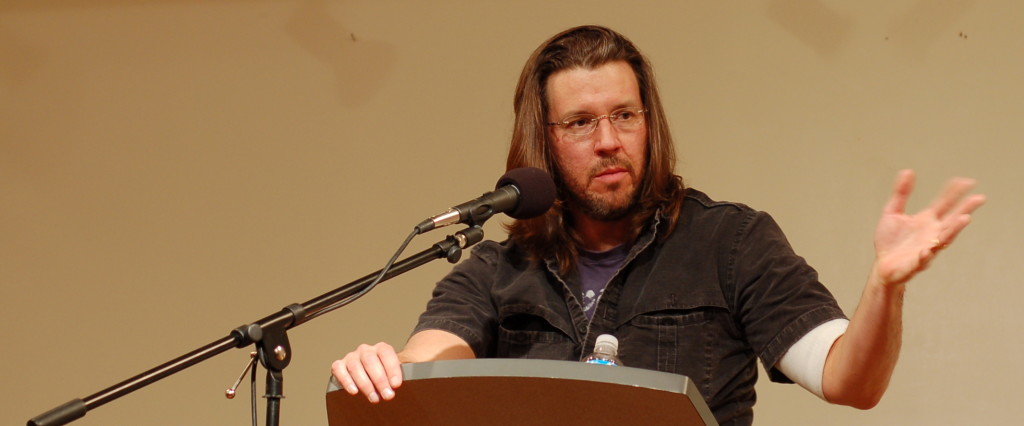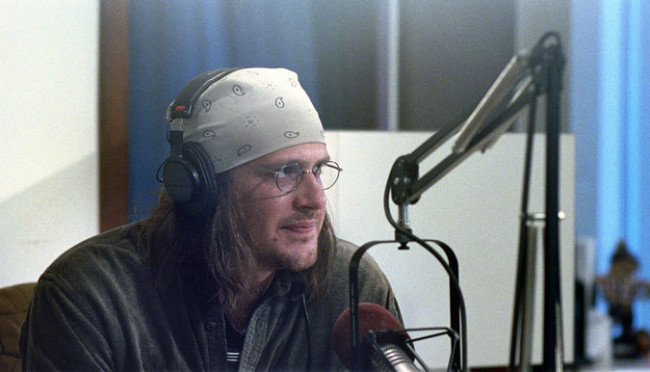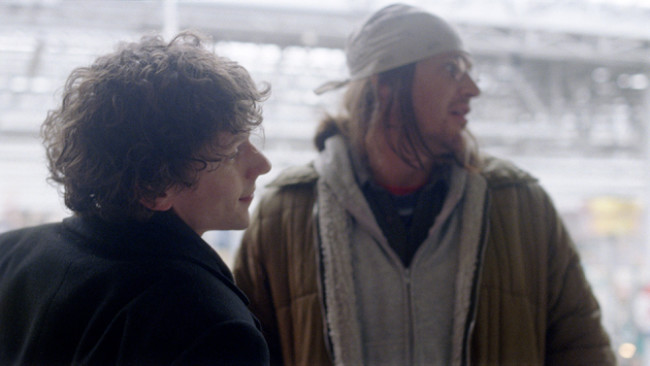 David Foster Wallace1 hung himself from a patio rafter on September 12, 2008, at the age of 46. He left behind family, friends, thousands of zealous fans, as well as a few hundred pages of finished material for an unfinished book, thousands of draft pages and notes scattered about his office-garage in bins, folders and floppy disks, and a two-page suicide note for his wife. Shortly before he died, Wallace stated that the “long thing” he had been working on was only a third of the way done.
David Foster Wallace1 hung himself from a patio rafter on September 12, 2008, at the age of 46. He left behind family, friends, thousands of zealous fans, as well as a few hundred pages of finished material for an unfinished book, thousands of draft pages and notes scattered about his office-garage in bins, folders and floppy disks, and a two-page suicide note for his wife. Shortly before he died, Wallace stated that the “long thing” he had been working on was only a third of the way done.
That long thing was eventually pieced together by Wallace’s longtime editor and friend, Michael Pietsch, and published as The Pale King in 2011. It was a finalist for the 2012 Pulitzer Prize, despite lacking the universal critical acclaim that had greeted its older sibling, Wallace’s consensus masterpiece, 1996’s Infinite Jest, a thousand page tragicomic meditation on the perils of entertainment addiction and the solipsistic entrapment of hyper self-consciousness. Infinite Jest was a work of colossal intellect, yet fundamentally sentimental in its attempt to re-mystify banal cliches regarding a meaningful life, and the silent magic of genuine inter-human connection.
Pietsch readily admits that the published version of The Pale King is his own version of the work, Wallace failing to leave behind any kind of instructional documentation as to how he intended the book to be plotted. The orphaned novel is thus oddly composed of Wallace’s words, while fundamentally not his book.
This same phenomenon seems to be at work again in this summer’s The End of the Tour, a road-trip biopic that depicts the final five days of Wallace’s book tour for Infinite Jest, in which he is accompanied by fellow writer David Lipsky, on assignment for Rolling Stone. Wallace is played by Jason Segel, while Jesse Eisenberg is cast as Lipsky. The script of the movie is based on tape recordings from the two writers’ multi-day conversation. (Lipsky’s piece was never printed by Rolling Stone, but the transcripts were eventually published, with annotations, as the book Although of Course You End Up Becoming Yourself, in 2010.) The End of the Tour is a product once again grounded in Wallace’s words, and yet, according to those who actually knew him, and many of those who didn’t, lacking in the late writer’s spirit.
Wallace’s estate made it explicitly clear during the film’s production that they were opposed to the movie’s eventual release, stating that they would neither “endorse nor support” the film, considering it an inaccurate homage that devalued Wallace’s writing while propagating a bloated, tragic-romantic image of him as tortured artist, too good for our toxic world.
Reductive myth-making seems almost unavoidable given the parameters of cinematic form. Wallace was a writer whose magnum opus was 1,079 pages long with 304 endnotes. A 106 minute long movie covering five days of his life can only hope, at best, to offer a sliver of his identity and capacity. So what you end up with is a Sparknote’d version of Wallace, one that will resonate most with those who know him as the guy responsible for the “This is Water” commencement speech their high school teacher made them watch during their last class of senior English.
For some, this is an irredeemable sin.2 Writers are meant to be read, rather than seen or heard, consumption of the written word requiring a certain level of engagement that simply can’t be matched by a movie or YouTube video. There’s no play button on a book: the story doesn’t go on unless the reader is presently working to make it do so.

Wallace may serve as an especially strong case for these objections. A large portion of his work was devoted to his own concerns with visual entertainment culture at large, and the extremely lopsided model of interaction that it propagated, offering maximum stimulation in exchange for minimal attention. And while reading as a general activity requires a certain standard of engagement that video/audio consumption doesn’t, reading Wallace is a particularly exhaustive affair, given the range of his vocabulary, the logistical length and intellectual density of his average piece, his preference for avant-garde structuring and the foot/endnote habit he became famous for.3
The Wallace ultimately portrayed in The End of the Tour is the Wallace too-often deified by casual viewers of “This is Water.”7 It doesn’t include the Wallace who wrote a thousand pages on addiction, but instead idolizes the one who said literature’s primary job was to simply “make people feel less lonely.” This is the Wallace with the big brain who thought the heart was a more important organ. It isn’t antithetical to Wallace’s work, but it is a pleasant simplification.
And yet, I promise you that I still liked this movie. Quite a bit, actually.
The End of the Tour’s saving grace is that it is largely self-aware of it’s own limitations as a vehicle for Wallace’s ideas and character. It’s a movie about the mythological processing of the man, wrestling with the constructs of celebrity even as it in some ways fundamentally and implicitly can’t help but advance the celebrity agenda of the DFW Industrial Complex.4
The story is more about David Lipsky than it is about David Wallace, the interviewer an in-film ambassador for an audience trying to gain access into the inner life of DFW. The first time Lipsky sees Wallace, it’s through the windshield of his car as he’s pulling into Wallace’s snowy driveway. The last time he sees Wallace is again through this windshield, backing out of the driveway upon the completion of the tour. The window as a screen is a simple, yet instructive model: Wallace can be seen, and interacted with, and there for the observer, yet essentially separate, and ungraspable.

And yet, just as the film can’t help but propagate the myth it hopes to untangle, neither can Segel’s best attempts at re-animating Wallace alleviate that basic hunch that any portrayal of Wallace on screen is somehow off. Part of what makes Segel-as-Wallace so inherently strange and discomforting, no matter how objectively good the acting is, is that Wallace never explicitly wrote about his own life. This is why the Wallace estate rejected the film without ever seeing it: even if the filmmakers could somehow theoretically recreate Wallace’s life in perfect detail, accurate in every atom of composition, it still wouldn’t change the fact that Wallace never wanted his own life translated into artifice.5
The estate has remained quiet since the movie’s release, but that hasn’t stopped a variety of other critics from taking up the fight, all of them essentially arguing that “this isn’t Wallace because if you read Wallace you would know that x, y and z”–a line of thought that implicitly suggests that while the movie doesn’t get Wallace, the critic does. But with this, critics of the film end up committing the same crime they critique.
The guy killed himself. Let’s not pretend like there’s any amount of reading we can do of his work that will ultimately allow us a full or even reasonably firm grasp of his inner-working as a person. And yet, the critical essays on The End of the Tour continue to pour in, arguing for one image of Wallace over another. It’s a demonstration as to the importance of the movie itself, as both film and the conversation surrounding it work to exhibit just how well Wallace spoke to the realities of our life, how well he seemed to connect with his readers, even if we had no prospect at comprehending the realities of his life, even if it was only a one-way connection. We want to know him - think we know him - because of how well he seemed to know us.
“He had a vocabulary for things that everybody feels,” said Segel, “But don’t know how to express.” This is a romantic notion, and one that is true for Wallace, yes, but also for just about any fiction writer of reasonable talent. What made Wallace special wasn’t his ability to lasso great emotions from out of the sky, and domesticate them into the written word. Rather, he meticulously built from the ground up, constructing characters, plots and universe’s out of the basic instincts, habits and perversities of everyday life in a hyper-media-saturated world. Wallace wrote about the things you weren’t supposed to write about, the mundane, digitally based routines - the TV watching and internet surfing - that rarely find their way into serious fiction yet compose a staggering amount of our conscious existence.6 These were not thoughts you couldn’t find the words for, but rather thoughts you had but weren’t even aware of, and didn’t even know needed articulation or exploration.
This is why reading David Foster Wallace is incredibly consoling, while reading about him incredibly crushing. Because for many of his readers, myself included, this was the first person we found who seemed to know us better than we knew ourselves. He wasn’t articulating our thoughts as much as he was our thinking, conscious and not.
Wallace was the ultimate tour guide for a certain kind of American with a certain material comfort and a certain amount of education and accomplishment and yet a certain itch they could not scratch, though bloodying themselves in the attempt. He understood, and could so clearly articulate, that certain species of unhappiness bred by entertainment overload. He understood the solitude that is exacerbated, rather than solved, by an interconnected world. He understood, and could articulate, that bad thing that once it’s found you never seems to leave, that shark that haunts below the ice. And it seemed like he knew the way out, that his ability to articulate these fears and obsessions meant that he had control, that he was speaking from the position of enlightened survivor.
But of course, Wallace himself would tell you that self-awareness wasn’t enough, that being knowledgeable about life, and oneself, never made either of those any the more bearable or redeemable. This was a message explicit in his work, re-confirmed in the facts of his biography. He was working on a book about finding meaning and bliss in the banalities of modern life. And then he killed himself.
Wallace’s ability to detail and describe depression did not, ultimately, make him invulnerable to it. Articulation wasn’t enough for salvation. The mythologizing of Wallace as hero for the digitally depressed is but another empty advertisement, and yet we cling to it, a fact that, while rattling the fears of his family, only demonstrates how painfully resonant his messages were.
Wallace had a gift for revealing certain screens in our life that may look like windows, but are actually mirrors. The End of the Tour is another mirror disguised as a window, telling us more about ourselves than it does the man on the other side of the page. It may be too meta, or too sentimental, but I’m convinced that the movie succeeds as a monument to DFW because it continues to exhibit, both within itself and the think-piece fervor it’s generated, our collective desire to know Wallace in the same way he seemed to know us, no matter that desire’s tendency towards reductive mythologizing.
We are lucky to still have the gift of his words - may they help us to come to terms with the fact that we never really had him.
***
Photos courtesy of here and here
Notes and Errata
| 1. | ↑ | To those close to him, “Dave” (apparently). To most fans, “DFW.” |
| 2. | ↑ | Perhaps even for Wallace himself, who, in his review of Edwin Williamson’s Borges: A Life, described the “intentional fallacy” as a conflation of a writing’s agenda and it’s author persona, arguing that there exists an inherent paradox in literary biographies: “It often seems, that the person we encounter in the literary biography could not possibly have written the works we admire. And the more intimate and thorough the bio, the stronger this feeling usually is.” |
| 3. | ↑ | This is a guy who put 304 endnotes at the back of a thousand page book with the sincere intention of forcing the viewer to casually toss hundreds of pages back and forth across their lap as they jumped from text to notes, a trip often rewarded by either a note that was a only a line long, begging the question of necessity, or one that was multiple pages, with endnotes of its own, so thick and fully-fleshed that it completely wiped the reader’s mind as to where they even were in the original text, once they finally made their way back to it. This is a writer who claimed that this same thousand page book should take a solid month to read and is intended to be read multiple times for full effect.* Wallace demanded an effort on behalf of the reader that, in some fundamental way, speeches and films are incapable of asking for.
*I can’t even imagine what kind of diamond-studded membership card this would earn you in the DFW fanclub, which more or less is a real thing, that more or less requires an actual reading of Infinite Jest for membership. I’m going to be an asshole and say that I’m pretty much OK with that, as pretentious as it may be, largely because a self-awareness and self-loathing of this pretentiousness is the second prerequisite for entrance into DFW-fan-land. |
| 4. | ↑ | The movie deserves some high-fives for at least acknowledging some of the unseemlier aspects of Wallace’s life and works that are often left out of his myth-image: his possessive jealousy with regards to certain members of the opposite sex, his addiction to chewing tobacco/cigarettes, and his tendency to most strongly connect, via his writing, with middle to upper class, white, college educated males, a demographic of which, if you couldn’t already tell, I am undeniably a member of. |
| 5. | ↑ | Despite my praise for this movie, it should be noted that even though he’s dead and unable to put out a statement himself, by all reasonable accounts, it’s safe to say that Wallace would have absolutely loathed being portrayed on film due to his own hyper-anxiety around controlling his public image. The only hope for redemption from Wallace’s ghost might be the inherently paradoxical nature of film being used to explore ideas of reality, i.e. it’s kind of funny that we have to rely on a combination of scripts, actors, wardrobe artists, cameras, film-editing software, etc. in order to provide us a fictional world in which we can talk about what it means to be real. It’s kind of funny that we need artifice to talk about reality in the same way that it’s kind of funny that we so often need humor to talk about anything serious. Funny, because it’s also kind of sad. |
| 6. | ↑ | This is probably why Harold Bloom, the most influential literary critic alive, said of Wallace, “He can’t think, he can’t write. There’s no discernible talent.” Bloom’s wife handles his emails. The guy is not living in the same digital-media-saturated world that the rest of us currently occupy. It’s not surprising that he found nothing of discernible value in Wallace’s work. (Wallace also called Bloom’s writing “turgid,” so there’s that.) |
| 7. | ↑ | I love “This is Water.” But genre’s have their limits, and phenomenal commencement speech does not equate to phenomenal representation of Wallace’s ideas and/or intellectual resume. On an additional, more cynical, note: the publication of this speech as a one-line-per-page book is the most obnoxious money-grab ever made with regard to DFW’s work. If his estate is truly confident that “David would never have agreed that [Lipsky’s] saved transcripts could later be repurposed as the basis of a movie,” then I’m pretty sure we can say that it’s doubtful he would have wanted a 20 minute speech turned into a book with his name on the byline. |
